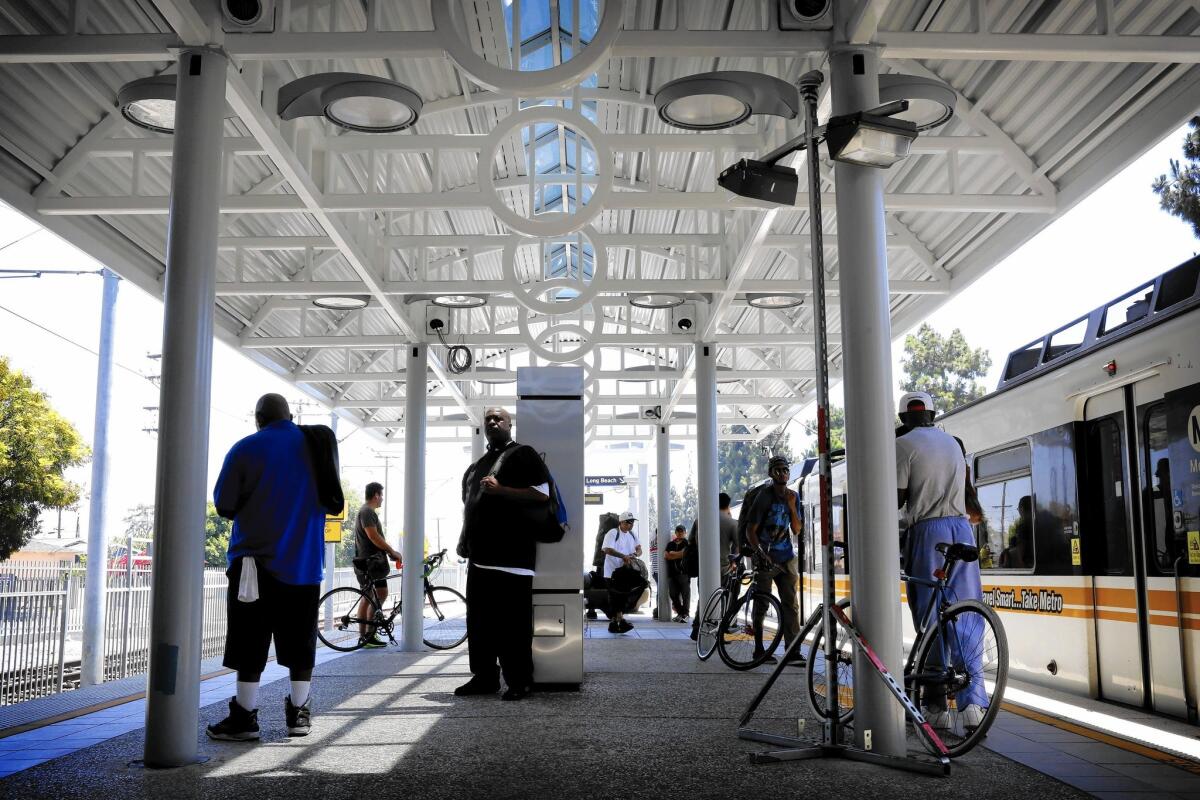Metro’s dreary, dangerous Rosa Parks Station in Willowbrook to get a major makeover

Commuters wait at Metro’s Rosa Parks Station, built 25 years ago, at Imperial Highway and South Wilmington Avenue in what is now a predominantly low-income Latino community.
- Share via
For years, Metro’s Rosa Parks Station in Willowbrook has been one of the busiest, dreariest and most crime-ridden light-rail stops in Los Angeles County.
Much of the Blue Line platform squats under the noisy 105 Freeway, its vast expanse of gray concrete amplifying the station’s drabness. Transit riders have complained about safety, crowded platforms, poor lighting, broken elevators and limited access to Wilmington Avenue.
As the 50th anniversary approaches of the riots that began in nearby Watts and highlighted L.A.’s stark socioeconomic disparities, county leaders and transportation officials say the community deserves better.
They are undertaking an ambitious plan to transform the facility and develop adjacent properties to create a more attractive link to local businesses, county services and a rebuilt Martin Luther King Jr. Community Hospital, which reopened this month.
Public and private investments of up to $1 billion are being made around the station, including $650 million to expand and remodel the medical complex two blocks away.
“The station is old, dingy, dilapidated and unsafe. Therefore, it is unacceptable,” said Los Angeles County Supervisor Mark Ridley-Thomas, who represents the unincorporated area. “The Rosa Parks Station should be the gateway to Willowbrook and the new Martin Luther King Jr. medical campus.”
The double-decked transit hub, which serves thousands of daily commuters, was built 25 years ago at Imperial Highway and South Wilmington Avenue in what is now a predominantly low-income Latino community.
The station’s name was changed from Imperial/Wilmington to Rosa Parks to commemorate the famous African American civil rights activist. It connects the Blue Line between Long Beach and downtown Los Angeles to the Green Line that runs from Norwalk to Redondo Beach, mostly in the median of the 105 Freeway. Six Metro bus lines and a variety of municipal buses and shuttles also use the stop, which has park-and-ride facilities and bike lockers.
“The station is really a crossroads for the county,” said Arturo Ybarra, director of the Watts/Century Latino Organization. “It needs to become a modern transportation center and include more multicultural art, better lighting and more attention from law enforcement and social services.”
In fiscal year 2014-15, the Rosa Parks Station averaged 19,728 light-rail passengers a day, making it the fourth-busiest stop in the 80-station Metro rail system. Only 7th Street Metro Center, Union Station and North Hollywood rank higher, transit officials say.
Switching from the Green Line to the Blue Line recently with her boyfriend, Amanda Delgado of Compton, said the general atmosphere at the rail stop “is horrid, spooky.”
“I use grocery bags to carry my wallet instead of a purse to make it look like I don’t have any money,” said Delgado. She said she has been robbed at both the Rosa Parks and Compton stations and “there’s lots of sexual harassment” at the stops in the area.
An average of 103 serious felonies a year, such as rape, aggravated assault, robbery and burglary, were reported at the Willowbrook station from 2012 to 2014, or 6% of serious crimes reported for the entire countywide Metro bus and rail operation. An average of more than 300 lesser offenses were reported annually, about 8% of such crimes systemwide.
Because of stepped-up law enforcement, reports of crime at the station dropped sharply during the first five months of this year.
Delgado and her boyfriend, German Barriga, welcomed the planned improvements in and around the station, as well as the increased law enforcement, saying they would make the transit center safer.
The proposed $65-million Rosa Parks project would represent the largest investment the agency has made to upgrade a transit terminal. The most expensive so far has been the $60-million reconstruction of the El Monte bus station, completed in 2012.
To help pay for the project, planners are seeking a $10.25-million federal grant. This month, the state transportation department recommended that $39 million from fees imposed on businesses that produce greenhouse gases be allotted to the station and other Blue Line improvements. That funding must be approved by the California Transportation Commission.
One feature of the station redesign is a wide canopied transit mall that would extend into the Kenneth Hahn Plaza Shopping Center next door. It also would provide a clearly marked pedestrian corridor between the station and Wilmington Avenue.
The Blue Line platform would be extended south to reduce crowding and to bring it out from under the freeway. To get to and from the upper-level Green Line platform, upgrades would be made to escalators, elevators and stairways.
The station’s east bus depot also would be improved while the west bus depot would be reconfigured and moved out from under the highway. New landscaping, bikeways, improved signage, pedestrian crossings and parking, as well as a sheriff’s substation would be included.
On adjacent property, planners envision additional medical buildings and a new county library that will be part of a mixed-use development with more than 100 units of affordable housing for senior citizens. If all goes well, officials say, the redevelopment effort should be finished by 2018.
“The station has a long way to go to make it nice,” said Tim Lindholm, Metro’s executive officer for capital projects. “We want to flip it on its head, make it a bright, safe and secure place where you’d want to be.”
Follow on Twitter @LADeadline16 for transportation and aviation news.
ALSO:
Metro’s Blue Line is a microcosm of the community it serves
Metro could expand subway service to the downtown L.A. Arts District
Can L.A. Metro riders be more polite? New videos aim to teach public transit etiquette
More to Read
Sign up for Essential California
The most important California stories and recommendations in your inbox every morning.
You may occasionally receive promotional content from the Los Angeles Times.











